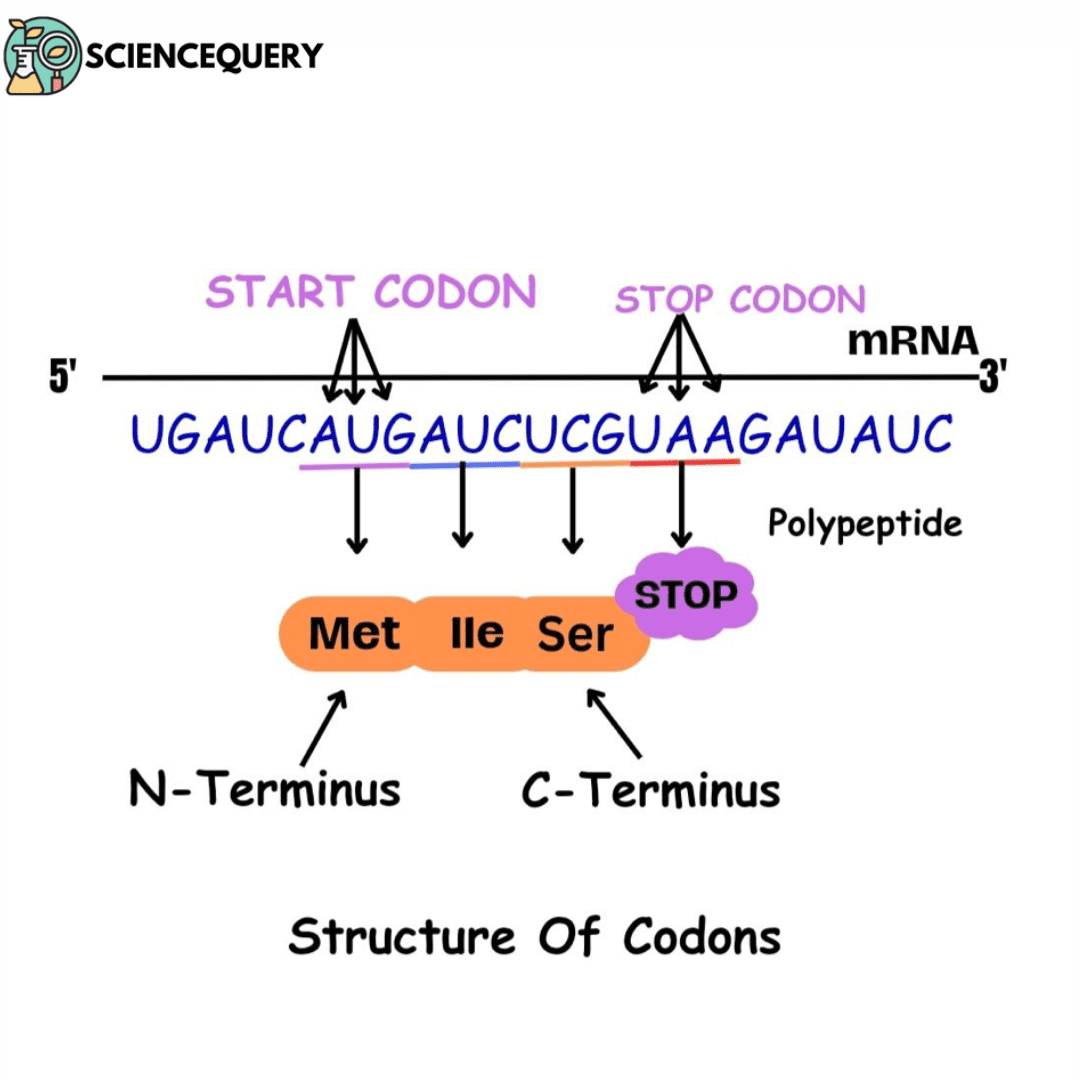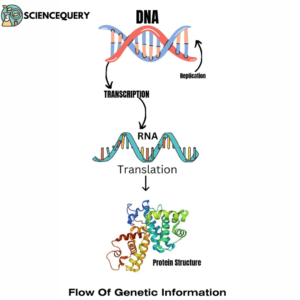
Introduction
What are genetic codons?
Genetic codons are sequences of three nucleotides that form the genetic code. The sequence of amino acids in a polypeptide is specified by a sequence of elementary codons within a gene. These elementary coding units are called codons. They are mostly triplets consisting of adjacent nucleotides, used in the synthesis of polypeptides.
They act as a “dictionary” for cells, guiding the specific amino acids to create proteins. Each codon is composed of one adenine (A), one guanine (G), and either cytosine (C) or thymine (T). For instance, if the sequence is AUG, then it directs the cell to produce methionine, an essential amino acid used in many proteins.
Importance in protein synthesis
The genetic information is present in sequences of the DNA. Initially, these sequences are used to synthesize RNA complementary to them- called transcription. The RNA is used as a template to specify the incorporation of amino acids in the polypeptide sequence called Translation. The three codes of nucleotides that are encoded in different amino acids are called Codons.
The genetic code also provides basic information about genes at the level of translation. In both the eukaryotes and prokaryotes, the codon AUG is used to initiate the polypeptide chains. In some cases, GUG is used as an initiation codon. This initiation codon is recognized by an initiator tRNA in eukaryotes. In prokaryotes, the AUG codon must follow a proper nucleotide sequence.
Genetic code basics
The genetic code is a nonoverlapping code, with each amino acid plus polypeptide inhibition and termination specified by RNA codons. The symbols or letters used in the codes are considered as bases. The genetic code also contains start and stop codons. Hence, specific codes are used to initiate and terminate polypeptide chains.
Role In Translation
The codons in mRNA molecules are recognized by aminoacyl-tRNAs during translation. Translation of a sequence of nucleotides in mRNA requires the accurate recognition of codons by aminoacyl-tRNAs. The property of degeneracy of the genetic code enables several different RNAs to specify a given amino acid. Moreover, the anticodon of a given tRNA must be able to pair with different codons.
It is not surprising that several tRNAs exist for certain amino acids while some tRNAs can recognize more than one codon.
Codon-chart and redundancy

Start and stop codons
Role of start codons in protein synthesis
The Initiation codons or start codons play a significant role in the protein synthesis.
- They are responsible for initiating the process of translation by binding to tRNA molecules.
- It also helps in determining the reading frame of mRNA transcripts, ensuring correct protein synthesis.
- Start codons act as recognition sites for regulatory proteins that are responsible for gene control expression.
Stop codon in termination and translation
Stop codons direct the end of translation and termination in protein synthesis. They translate mRNA into proteins. Stop codons are also called nonsense or termination codons as they do not code for any amino acid. The most commonly used stop codon is UAA (Uracil-Adenine-Adenine).
tRNA and codon recognition
This process includes the binding of tRNA molecules to specific codons. Hence it allows translation of genetic information into specific proteins. Each tRNA molecule has a unique specificity and binds only with certain codons on mRNA molecules.
Role of anticodon region in tRNA
The anticodons that are present on the tRNA molecules interact with complementary codons. present on mRNA molecules, It thus forms hydrogen bonds, enabling their recognition by one another.
Codon-reading machinery
The codon-reading machinery consists of three main components: ribosomes, transfer RNAs (tRNAs), and elongation factors.
- Ribosomes are made of two subunits – the large one that binds to mRNA molecules and is read in triplets called codons. The smaller unit catalyzes the peptide bond formation between amino acids.
- Transfer RNAs recognize particular codons present in mRNAs by base pairing them with complementary nucleotides.
- Elongation factors help in facilitating the synthesis of proteins by binding to mRNA molecules during initiation or termination events.
Mutation and codon changes
To introduce new evolutions, mutation, and codon changes are important factors in bringing these changes. The effects of mutations and codon changes depend upon the type of mutation changes, its location within the genome, and its location in coding or non-coding regions.
Mutations like point mutations involve a single-base pair change whereas structural changes like chromosomal rearrangements result from changed expression patterns.
Genetic disorders related to codon mutation
Codon mutation leads to several different genetic disorders.
Cystic fibrosis
which is caused by the recessive mutant allele in chromosome 7 of a gene. It thus results in the production of a special protein which leads to the formation of mucus containing high viscosity.
Sickle-cell anemia
It is another disorder that occurs because of single base substitution in the sixth codon of the beta-globin chain.
Q&A
1. Mention the three codons in the genetic code.
The three codons in the genetic code are AUG, UAA, and UAG.
2. How many codons are in one gene?
Generally, a single gene contains around 1,000 to 10,000 codons.
3. What are the genetic code codons of mRNA?
The genetic code codons of mRNAs are the sequences of three nucleotides that form the genetic information. Each codon is composed of one adenine, one guanine, and one cytosine. Possible combinations for these three bases are AUG, UAC, GUC, and CAG.
4. How do you find the codon of a gene?
The codon of a gene can be found by using a variety of methods :
- DNA sequencing- One of the reliable ways to identify the codons in a gene, as it provides an exact analysis of the sequence.
- Bioinformatics tools like BLAST (Basic Local Alignment Search Tool) use algorithms to determine codon sequences.
- Codon usage databases like NCBI’s Codon Usage Database or ENSEMBL’s Compare database. These databases contain information about codons that assist the researchers while studying about a particular gene.
Summary
- Genetic codons are sequences of three nucleotides that form the Genetic Code.
- The sequence of amino acids in a polypeptide is specified by a sequence of elementary codons within a gene.
- These elementary coding units are called codons. They are mostly triplets consisting of adjacent nucleotides, used in the synthesis of polypeptides.
- They act as a “dictionary” for cells, guiding the specific amino acids to create proteins.
- Each codon is composed of one adenine (A), one guanine (G), and either cytosine (C) or thymine (T).
- If the sequence is AUG, then it directs the cell to produce methionine, an essential amino acid used in many proteins.
- The RNA is used as a template to specify the incorporation of amino acids in the polypeptide sequence called Translation.
- The triplets of nucleotides that encode the different amino acids are called Codons.
- The codons in mRNA molecules are recognized by aminoacyl-tRNAs during translation.
- Genetic code also contains start and stop codons. Hence, specific codes are used to initiate and terminate polypeptide chains.
- Effects of mutations and codon changes depend upon the type of mutation changes, its location within the genome, and its location in coding or non-coding regions.
- Bioinformatics tools like BLAST (Basic Local Alignment Search Tool) use algorithms to determine codon sequences.
- ENSEMBL’s databases contain information about codons that assist the researchers while studying a particular gene.
References
- https://citeseerx.ist.psu.edu/document?repid=rep1&type=pdf&doi=450270ddf16353d879274211d08b9fa7f1ea5537
- https://onlinelibrary.wiley.com/doi/abs/10.1002/bies.201900201
- https://link.springer.com/chapter/10.1007/978-3-030-44496-9_5
- https://www.sciencedirect.com/science/article/pii/0022283668903926
- https://www.annualreviews.org/doi/abs/10.1146/annurev-genet-120116-024713
Written By: Sushmita Mukhopadhyay

